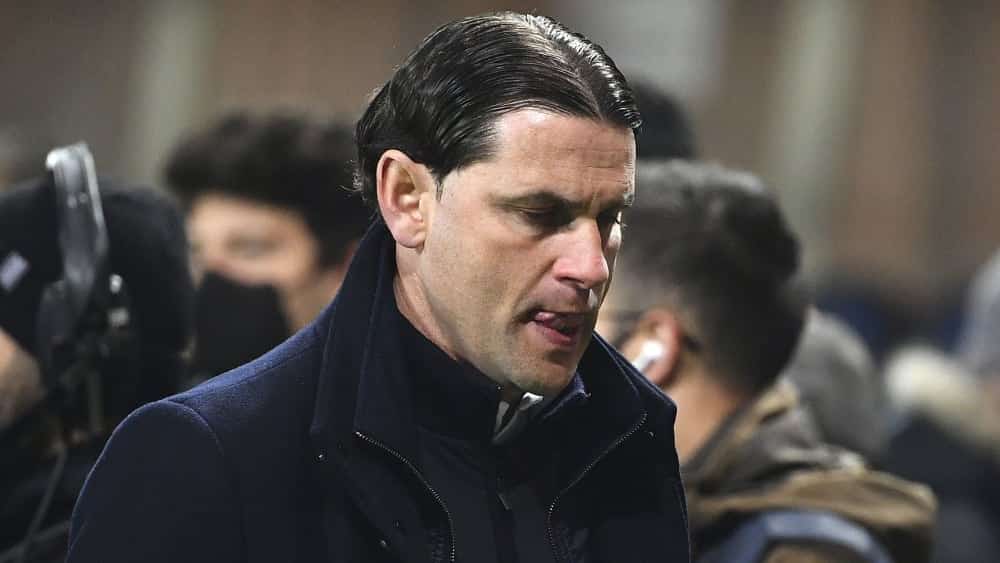In the flattering 2:3 defeat in Bergamo, Bayer showed glaring weaknesses and coach Gerardo Seoane an almost too late reaction.
Seoane was dissatisfied. Really dissatisfied. Because despite the narrow defeat (though only) in terms of the result, Bayer had not escaped with a black eye with the 2:3 at Atalanta Bergamo, but rather with a slight concussion.
In any case, the clear inferiority of his eleven is likely to cause the coach considerable headaches with regard to the second leg. After all, Seoane went on record saying he was “worried about what happened on the pitch.”
In fact, what happened after a beautifully played lead and eight dominant minutes by the Werkself was anything but confidence-boosting. After all, Bayer experienced a recurring nightmare.
After misplaced passes and tactical mistakes, the team disintegrated defensively into its individual parts. In the first half alone, Bayer was outplayed three or four times in the same pattern: Repeatedly, right-back Jeremie Frimpong tried to press or attack the opponent early on the flank – opening up spaces at his back for Bergamo’s attackers to run riot.
To the chagrin of defender and centre-back Jonathan Tah, who was repeatedly forced into running and one-on-one duels with Bergamo attacker Luis Muriel or left rail player Davide Zappacosta on the flank without any support and was put through the grinder by them.
For quite in contrast to the hosts, who operated variably in a 3-5-2, Bayer defended only as a collection of widely spaced individual players with sometimes frightening passivity. Atalanta had three free shots in the penalty area between the 20th and 27th minute.
“They put us in extreme difficulties,” Seoane judged. The outstanding Ruslan Malinovskyi and Muriel, who was hardly inferior to him, turned the game to 2:1. Thus, even before the change of ends, the question was not whether, but how Seoane would have to react. A switch to a three- or five-man backline was the obvious way to reduce the gaps. But even after the break, the Swiss remained with a 4-2-3-1 – and Bayer narrowly avoided disaster.
There was a good reason why Seoane did not react until later. He saw the change of system only as a last resort. “It was a way to better control those floating strikers who kept breaking out,” he explained, but pointed out that the opponent – unlike FC Bayern München on Saturday – did not actually necessarily require it because of their formation: “It was more a problem of pushing through quickly,” the coach stressed, “than of the system itself.”
And that is precisely the big puzzle for Seoane. After all, he had to recognise that his young team was incapable on this evening of learning from repetitive patterns and adapting tactically to the requirements. Not even after his half-time speech.
Only captain and goalkeeper Lukas Hradecky was to thank for the fact that the Werkself did not completely blow their chance of reaching the quarter-finals in the first quarter of an hour after the break. “We had a difficult start in the second half. We had Lukas to thank for keeping it at 3:1,” admitted Seoane.
It was only when the coach reacted to Leverkusen’s helplessness after an hour and switched to a 3-5-2 with centre-back Odilon Kossounou coming on for centre-forward Lucas Alario that Bayer achieved a certain compactness. “After that we caught ourselves a bit,” Seoane noted.
But whether a 3-5-2 is really the solution in the second leg, which Bayer must win, remains to be seen. In Bergamo, it was more of a last resort to avoid a serious system crash.
The fact that Moussa Diaby reduced the score to 2:3 after the changeover with an individual class performance only concealed Leverkusen’s clear inferiority on the scoreboard. It is true that Bayer – more through luck than skill – still have a realistic chance of reaching the quarter-finals in the second leg. But the collective failure in the truest sense of the word will cause Seoane even more headaches.
At the airport in Bergamo, he spent a long time analysing the situation, first with co-coach Patrick Schnarwiler and analysts Marcel Daum and Simon Lackmann, and later with sporting director Simon Rolfes. Finding the solution for the second leg is a complex task. Even the one-and-a-half-hour delay of the return flight was probably not enough for that.





